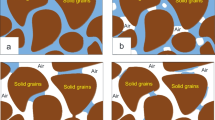Abstract
Variations in pore-water pressure determined by the groundwater table within a riverbank have been investigated and recognized as an essential factor in determining riverbank stability with respect to mass failure. However, the effect of pore-water pressure is taken into account for most of the existing riverbank stability models under some simplified assumptions, and the limitations of predicting ability may arise. To avoid the unrealistic estimation of pore-water pressure distribution, the new approach proposed here is to couple riverbank stability with groundwater flow modeling, and apply this to tackle the conjunction effect between river stage and groundwater table. Moreover, riverbank material characteristics and the influence of infiltration can be taken into consideration via groundwater flow modeling. Two hypothetical examples, stage rising and stage falling, are used to investigate the capabilities of the present study and two representative methods. The simulated results show that riverbank failure is triggered particularly during the falling stage, which has been pointed out by other researchers as well. Furthermore, the riverbank material characteristics predominantly control the occurrence of failure and should be considered regarding assessment of riverbank stability. Additionally, the effects of parameters indicate that riverbanks with soil properties of low permeability or high specific yield with great infiltration intensity during the falling stage have a tendency to riverbank failure.










Similar content being viewed by others
Abbreviations
- c :
-
A constant value (approximately 1.12)
- c′:
-
Effective cohesion
- FS:
-
Safety factor
- H :
-
Bank height
- H0(x):
-
Initial height of water table across the flow domain
- \( H_{1} (t)\,{\text{and}}\,H_{2} (t) \) :
-
Time fluctuating height of water table at the boundaries
- H w :
-
River stage
- h :
-
Height of water table
- I :
-
Recharge rate from infiltration
- K :
-
Hydraulic conductivity
- L :
-
Length of the failure plane
- l :
-
Length of the aquifer
- S :
-
Specific yield
- t :
-
Time coordinates
- V w :
-
Rising or falling velocity of the river stage
- x :
-
Space coordinates
- α :
-
Angle of riverbank
- β :
-
Failure plane angle
- ϕ′:
-
Effective friction angle of the soil
- ϕb :
-
Angle used to determine the rate of increase in shear strength due to increasing matric suction
References
Bear J (1972) Dynamics of fluids in porous media. Dover, Mineola
Casagli N, Rinaldi M, Gargini A, Curini A (1999) Pore water pressure and streambank stability: results from a monitoring site on the Sieve River, Italy. Earth Surf Process Landf 24(12):1095–1114
Darby SE, Thorne CR (1996) Development and testing of river-bank stability analysis. J Hydraul Eng 122(8):443–454
Darby SE, Gessler D, Thorne CR (2000) Computer program for stability analysis of steep, cohesive riverbanks. Earth Surf Process Landf 25:175–190
Fredlund DG, Rahardjo H (1993) Soil mechanics for unsaturated soils. Wiley, New York
Harr ME (1962) Groundwater and seepage. McGraw-Hill, New York
Lohnes RA, Handy RL (1968) Slope angles in friable loess. J Geol 76(3):247–258
Osman AM, Thorne CR (1988) Riverbank stability analysis. Part I: theory. J Hydraul Div ASCE 114(2):125–150
Rinaldi M, Casagli N (1999) Stability of streambanks in partially saturated soils and effects of negative pore water pressures: the Sieve River (Italy). Geomorphology 26(4):253–277
Simon A, Curini A (1998) Pore pressure and bank stability: the influence of matric suction. In: Abt S (ed) Hydraulic engineering '98. ASCE, Reston, pp 358–363
Simon A, Thomas RE (2002) Processes and forms of an unstable alluvial system with resistant, cohesive streambeds. Earth Surf Process Landf 27:699–718
Simon A, Wolfe WJ, Molinas A (1991) Mass-wasting algorithms in an alluvial channel model. In: Proceedings of the 5th federal interagency sedimentation conference, Las Vegas, Nevada, pp 8-22–8-29
Simon A, Curini A, Darby SE, Langendoen EJ (2000) Bank and near-bank processes in an incised channel. Geomorphology 35(3–4):193–217
Spangler MG, Handy RL (1973) Soil engineering, 3rd edn. Intext Educational, New York
Thorne CR (1982) Processes and mechanisms of river bank erosion. In: Hey RD, Bathurst JC, Thorne CR (eds) Gravel-bed rivers. Wiley, Chichester, pp 227–271
Thorne CR, Abt SR (1993) Analysis of riverbank instability due to toe scour and lateral erosion. Earth Surf Process Landf 18:835–843
Acknowledgments
The authors greatly appreciate the financial support of the Water Resources Planning Institute, Water Resources Agency of Taiwan, under projects 097-B-01030-001-003 and 098-B-01040-001-410.
Author information
Authors and Affiliations
Corresponding author
Rights and permissions
About this article
Cite this article
Chiang, SW., Tsai, TL. & Yang, JC. Conjunction effect of stream water level and groundwater flow for riverbank stability analysis. Environ Earth Sci 62, 707–715 (2011). https://doi.org/10.1007/s12665-010-0557-8
Received:
Accepted:
Published:
Issue Date:
DOI: https://doi.org/10.1007/s12665-010-0557-8




